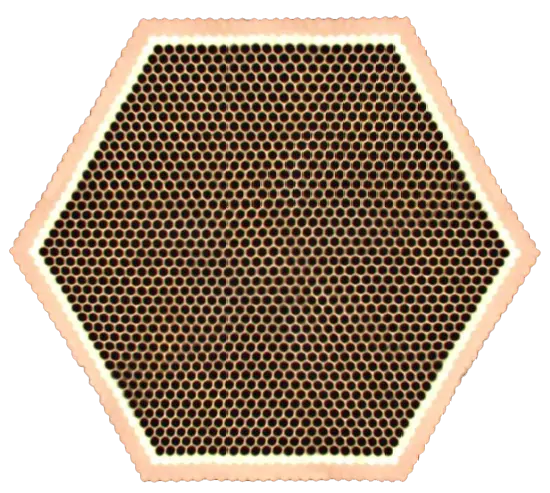A polycapillary chromatographic column (PCC) is a component product that is used to separate different constituents of a mixture based on their chemical properties.

The PCC is made, as a rule, of glass, and contains a plurality of parallel channels isolated from each other, the walls of which are covered with sorbent on the inner side, and the outer sides are fused with the walls of adjacent channels.
Polycapillary columns have unique characteristics:
- separation efficiency depends weakly on the carrier gas flow rate in the range of 30-200 cm3/min;
- mass of the analyzed component in the gas sample can be relatively large and amount to 0.5-3 µg, which is sufficient for reliable detection of separated substances by detectors with the volume of 0.1-1 cm3;
- separation of substances takes place at low temperatures due to the small diameter of capillaries, which significantly reduces the energy consumption of a stand-alone device
Advantages of polycapillary columns:
- allow chromatographic analyses in the fast chromatography mode, namely, to perform them tens of times faster than conventional packed columns and capillary columns;
- have high specific efficiency up to 12-14 thousand theoretical plates per meter and higher;
- maintain high efficiency over a very wide range of carrier gas flow rates;
- compatible with chromatographs operating with conventional capillary and packed columns;
- allow sample separation at a lower temperature than other columns, which is important when analyzing labile compounds;
- allow to increase the analytical sensitivity, which is important for the determination of microimpurities.
A unique feature of polycapillary columns is the possibility of their use both at high carrier gas flow rates (up to 1000 ml/min and more) and at moderate pressures at the column inlet.
Application
Polycapillary columns are used in areas where a rapid method of gas chromatography is required:
- Oil production: oil and condensate refining, simulated distillation (SimDis), analysis of organochlorine compounds in oil, analysis of hydrogen sulfide, methyl and ethylmercaptans, component-fraction composition of gas condensate, liquefied gas analysis, natural gas and refinery gas analysis, gasoline analysis.
- Transformer diagnostics: gas chromatography has long been one of the permanent methods for condition monitoring of high-voltage transformers in the power industry.
- Ecology: gas chromatography is widely used in water, soil and air pollution control.
- Food control: analysis for authenticity and toxic impurities in food and beverage.
- Medicine: pharmacy and toxicology as well as medical diagnostics. Determination of volatile substances in exhaled air for early diagnosis of diseases such as lung, larynx, mouth and esophageal cancer.
- Forensics, security: detection and analysis of explosives and narcotic substances, adulterated alcoholic beverages, identification of incendiary mixtures in fire and technical expertise, control and detection of adulteration of automobile fuels and POL, use by mine rescue brigades of the EMERCOM in the control of air in mines.
- Agriculture: determination of nitrate and phosphate, pesticides in soil, water and agricultural products, determination of nutritional value of feed.
VTC Baspik holds the manufacturing process for multichannel tubes (MCTs) for polycapillary columns.
MCT characteristics
| Parameter | Value, description |
|---|---|
| Channel diameter, µm | 40±2 |
| Number of single-channel tubes (capillaries) in MCT, not less, pcs. | 1000 |
| Number of rows of protective rods (shells) | 3 |
| Form of а capillary bundle with protective rods is hexagonal, size by double apothem, mm | 2 ± 0.1 |
| Channel diameter spread measured in one section, not more than, % | 2 max |
| MCT length, mm | 1150 to 1200 |
| Capillary and protective rod (shell) material | lead-silicate glass |
Development status: accepting requests for manufacturing MCT prototypes